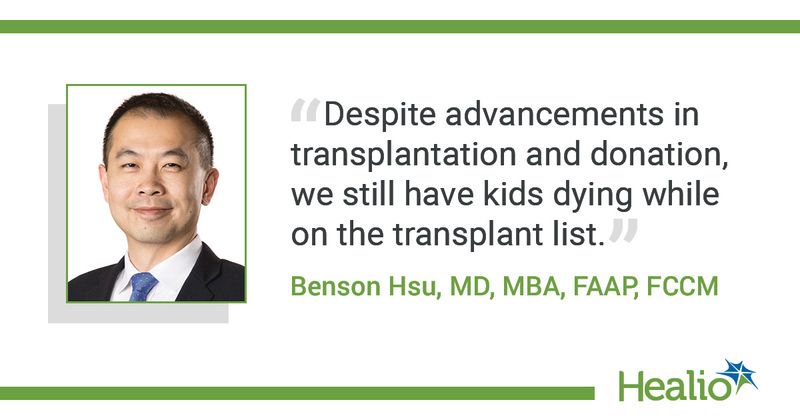Q&A: AAP updates guidance on pediatric organ donations
Key takeaways:
- More than 1,700 children annually receive an organ transplant, and hundreds more remain on the waiting list.
- The AAP updated guidance on pediatric organ donations for the first time in 13 years.
The AAP updated its policy statement on pediatric organ donation for the first time in 13 years, focusing on guidance to help clinicians navigate difficult organ donation and transplantation decisions.
The United States is in the midst of an organ shortage, and pediatric transplants have remained below pre-pandemic rates, according to a study published last year.

According to the AAP, more than 1,700 children and teens annually receive an organ transplant, and hundreds more remain on the waiting list.
We spoke with Benson Hsu, MD, MBA, FAAP, FCCM, a professor of pediatric critical care medicine at the University of South Dakota Sanford School of Medicine, about the policy updates, how organ donation has changed since 2010, and how providers can address organ donation with parents.
The policy statement was published this week in Pediatrics.
Healio: What has changed since the last edition of the guidelines in 2010?
Hsu: Since the last statement, there has been an increase in several areas, including donations after circulatory death (DCD). There is also increasing potential for DCD within the neonatal population.
Ultimately, there continues to be a great need for lifesaving donations. It is worth mentioning that despite advancements in transplantation and donation, we still have kids dying while on the transplant list. This is an important topic that all pediatric care providers can be a part of, whether within their clinic, at the hospital or in shaping public policy.
Healio: What are the most prominent updates in this edition?
Hsu: The major shift of this edition is the focus on the pediatric care provider. Specifically, the statement explores the before and after of a donation and transplantation process, equipping those who may not directly work in the ICU or with donation and transplantation with knowledge of how to understand and care for this population.
Healio: How do you recommend providers discuss this issue with parents?
Hsu: Clearly, discussions around donation and transplantation occur often at the end of life. We recommend that providers engage in earlier discussions with patients with chronic illnesses possibly needing transplantation in the future, as well as patients and families interested in learning more about donation even when the patient is otherwise healthy.
Open, transparent conversations built on the trust of the relationship between primary care providers and their patients and families will be the key.
References:
Feldman AG, et al. Semin Pediatr Surg. 2022;doi:10.1016/j.sempedsurg.2022.151178.
Hsu B, et al. Pediatrics. 2023;doi:10.1542/peds.2023-062923.
Nimmo A, et al. Transplantation. 2022;doi: 10.1097/TP.0000000000004151.
